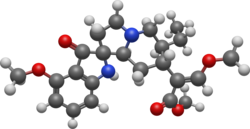Chemistry:Mitragynine pseudoindoxyl
 | |
 | |
| Clinical data | |
|---|---|
| Other names | Spiro(2H-indole-2,1'(5'H)-indolizine)-7'-acetic acid, 6'-ethyl-1,2',3,3',6',7',8',8'a-octahydro-4-methoxy-alpha-(methoxymethylene)-3-oxo-, methyl ester, (alphaE,1'S,6'S,7'S,8'as)- |
| Identifiers | |
| |
| CAS Number | |
| PubChem CID | |
| ChemSpider | |
| ChEMBL | |
| Chemical and physical data | |
| Formula | C23H30N2O5 |
| Molar mass | 414.502 g·mol−1 |
| 3D model (JSmol) | |
| |
| |
Mitragynine pseudoindoxyl is a rearrangement product of 7-hydroxymitragynine and active metabolite of mitragynine.[1] It is an analgesic being more potent than morphine.[2][3]
Dependence and withdrawal
Pharmacology
Mitragynine pseudoindoxyl is a μ opioid receptor agonist and δ opioid receptor antagonist and acts as a G protein biased agonist at μ opioid receptors and possesses a favourable side effect profile compared to conventional opioids.[4] Cryo-EM structures of μOR-Gi1 complex with mitragynine pseudoindoxyl and lofentanil (one of the most potent opioids) revealed that the two ligands engage distinct subpockets, and molecular dynamics simulations showed additional differences in the binding site that promote distinct active-state conformations on the intracellular side of the receptor where G proteins and β-arrestins bind.[5] Importantly, studies have shown that oxidative metabolism is capable of transforming mitragynine (the main alkaloid in kratom) into mitragynine pseudoindoxyl in two steps, which is likely to influence kratom's complex pharmacological effects.[6][7][8]
Chemistry
Mitragynine pseuodoindoxyl was first accessible via biomimetic semisynthesis from mitragynine.[2][3][4] Total synthesis of an unnatural analogue was reported featuring an interrupted Ugi reaction as the key step.[9] Scalable and modular total synthesis of the natural product has been also accomplished using a chiral pool based strategy.[10][11] This study also demonstrated structural plasticity in biological systems.
See also
References
- ↑ "Ethnopharmacology of kratom and the Mitragyna alkaloids". Journal of Ethnopharmacology 23 (1): 115–119. 1988. doi:10.1016/0378-8741(88)90121-3. PMID 3419199.
- ↑ 2.0 2.1 "Studies on the synthesis and opioid agonistic activities of mitragynine-related indole alkaloids: discovery of opioid agonists structurally different from other opioid ligands". Journal of Medicinal Chemistry 45 (9): 1949–1956. April 2002. doi:10.1021/jm010576e. PMID 11960505.
- ↑ 3.0 3.1 "Opioid receptor agonistic characteristics of mitragynine pseudoindoxyl in comparison with mitragynine derived from Thai medicinal plant Mitragyna speciosa". General Pharmacology 33 (1): 73–81. July 1999. doi:10.1016/S0306-3623(98)00265-1. PMID 10428019.
- ↑ 4.0 4.1 "Mitragynine/Corynantheidine Pseudoindoxyls As Opioid Analgesics with Mu Agonism and Delta Antagonism, Which Do Not Recruit β-Arrestin-2". Journal of Medicinal Chemistry 59 (18): 8381–8397. September 2016. doi:10.1021/acs.jmedchem.6b00748. PMID 27556704.
- ↑ "Insights into distinct signaling profiles of the µOR activated by diverse agonists". Nature Chemical Biology 19 (4): 423–430. April 2023. doi:10.1038/s41589-022-01208-y. PMID 36411392.
- ↑ "Unveiling 7-Hydroxymitragynine as the Key Active Metabolite of Mitragynine and the Promise for Creating Novel Pain Relievers". ACS Central Science 5 (6): 936–938. June 2019. doi:10.1021/acscentsci.9b00462. PMID 31263752.
- ↑ "Metabolism of a Kratom Alkaloid Metabolite in Human Plasma Increases Its Opioid Potency and Efficacy". ACS Pharmacology & Translational Science 3 (6): 1063–1068. December 2020. doi:10.1021/acsptsci.0c00075. PMID 33344889.
- ↑ "Oxidative Metabolism as a Modulator of Kratom's Biological Actions". Journal of Medicinal Chemistry 64 (22): 16553–16572. November 2021. doi:10.1021/acs.jmedchem.1c01111. PMID 34783240.
- ↑ "A chemical synthesis of 11-methoxy mitragynine pseudoindoxyl featuring the interrupted Ugi reaction". Chemical Science 3 (9): 2849–2852. September 2012. doi:10.1039/C2SC20669B. PMID 23878716.
- ↑ "Syntheses and structural plasticity of kratom pseudoindoxyl metabolites" (in en). ChemRxiv. 2023-02-02. doi:10.26434/chemrxiv-2023-62vzz-v2. https://chemrxiv.org/engage/chemrxiv/article-details/63dab15989c04b6693c92cba.
- ↑ "Total Synthesis and Structural Plasticity of Kratom Pseudoindoxyl Metabolites". Angewandte Chemie 62 (35): e202303700. June 2023. doi:10.1002/anie.202303700. PMID 37332089.
 |

